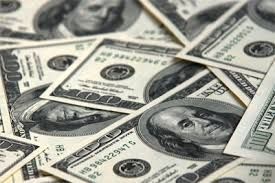BISHKEK (TCA) — Kyrgyzstan’s public debt has amounted to $4.4 billion (58% of GDP) of which $3.885 billion is the state’s external debt. $320 million Kyrgyzstan will have to pay off by 2023.
The Ministry of Finance of Kyrgyzstan plans to increase the threshold of the ratio of public debt to GDP up to 70%. The Economy Ministry does not see any problem in this initiative because Kyrgyzstan will not violate agreements with creditors. According to the law, the threshold of the ratio of state debt to GDP should not exceed 60% but it was not always observed. As of January 1, 2018, the ratio was 63%. Not to break the law, the Government decided to increase the threshold.
However, this may have certain threats. If there are fluctuations in foreign currency rates, it will be difficult for the State to service Kyrgyzstan’s external debt because it is in foreign currency.
Debts to China
Over the past five years, China’s share in Kyrgyzstan’s foreign debt has grown from 2% to 44%, MP Akylbek Japarov said at a parliamentary meeting.
The Government plans to spend $191 million to serve foreign debt this year. In five years, this amount will reach $320 million which is a very big burden for the country, Japarov added.
Kyrgyzstan’s debt to China ($1.7 billion) is especially big. Within five years, Kyrgyzstan should pay $1.5 billion to the Export-Import Bank of China, he said.
According to agreements with the Eximbank, Kyrgyzstan’s debt is not subject to write-off, and its term cannot be extended. Moreover, all disputable issues on loans should be settled under Chinese laws and in Hong Kong. This is the result of the authorities’ wrong policy, the MP believes. Before borrowing huge amounts, the Government had to consider whether Kyrgyzstan’s could pay off this money.
The MP recalled the words of Russian MP Vladimir Zhirinovsky, a member of the Russian State Duma (Parliament), who opposed the write-off of Kyrgyzstan’s $240 million debt to Russia earlier this year and proposed the country to lease Issyk-Kul Lake to Russia for 99 years and thus to repay its debts. China also can choose a similar way, Japarov suggested, adding that Tajikistan, Pakistan and Sri Lanka had already given their lands, deposits and large enterprises to China to repay their debts.
Finally, the Russian State Duma ratified the protocol on writing off Kyrgyzstan’s debts.
China has never written off loans to its debtors, so Kyrgyz authorities will have to look for other ways of paying off the debt, for example, to take loans from other countries. It is unlikely that Russia will help Kyrgyzstan this time because it recently wrote off all debts to Kyrgyzstan, local experts believe.
From 2019, payments on foreign loans will significantly increase in the energy sector. The peak will be in 2025, when the annual amount of payments will reach 11.8 billion soms, head of Kyrgyzstan’s State Committee for Industry, Energy, and Subsoil Use Ulanbek Ryskulov said at a meeting with Prime Minister Mukhammedkaly Abylgaziev.
The Prime Minister stressed that due to the recent developments [a major accident at the Bishkek Thermal Power Plant in January and subsequent criminal cases initiated against several top managers] the society’s confidence in the energy sector has significantly reduced.
China, through the Government’s Export-Import Bank, has funded projects in the energy sector in Kyrgyzstan.
In 2013, Kyrgyzstan completed the construction of the Datka substation for a $208 million loan from Eximbank. Its construction marked the beginning of a larger project, the construction of the Datka-Kemin power transmission line worth $389 million. The Eximbank allocated this money, too.
In 2013, the Bank allocated $386 million for the reconstruction of the Bishkek TPP. Under the loan agreement between the Kyrgyz Government and the Export-Import Bank of China, the Kyrgyz Finance Ministry was granted a $386 million soft loan at a 2% interest rate per annum and a maturity of 20 years. The loan was issued under the guarantee of the Kyrgyz Government.
Gold mine for debt
In April 2018, Tajikistan handed over to China the Upper Kumarg gold mine in the Sughd oblast to pay off its debt borrowed to modernize the Dushanbe-2 TPP, eadaily.com reported. The Chinese company TBEA will develop the mine. Previously, this company had already gained access to the East Duoba gold deposit in Tajikistan. According to the Central Geology Administration under the Government of Tajikistan, the Chinese company will produce gold in the field until it returns the funds invested in the construction of the Dushanbe-2 TPP, and then a new agreement will be signed on new terms.
Earlier, TBEA received the right to develop a coal deposit in Tajikistan. Several Chinese companies are engaged in the extraction of precious metals in Tajikistan. China has licenses to develop seven gold deposits in Tajikistan.
Tajikistan was among the first Central Asian countries to receive cheap loans and grants from China, allocated on preferential terms for long periods of time, from 20 years and more. Compared to the more difficult access to Russian and Western financial resources, Chinese proposals were more attractive. This explains why China is more easily accessing Tajik minerals than Russia, experts say.
According to the Tajik Finance Ministry, Tajikistan’s external debt exceeded $2.3 billion in 2017 and the debt to China was more than half of this amount, $1.2 billion.
Experts from both countries, Tajikistan and Kyrgyzstan, say the countries’ dependence on China could threaten their sovereignty.








